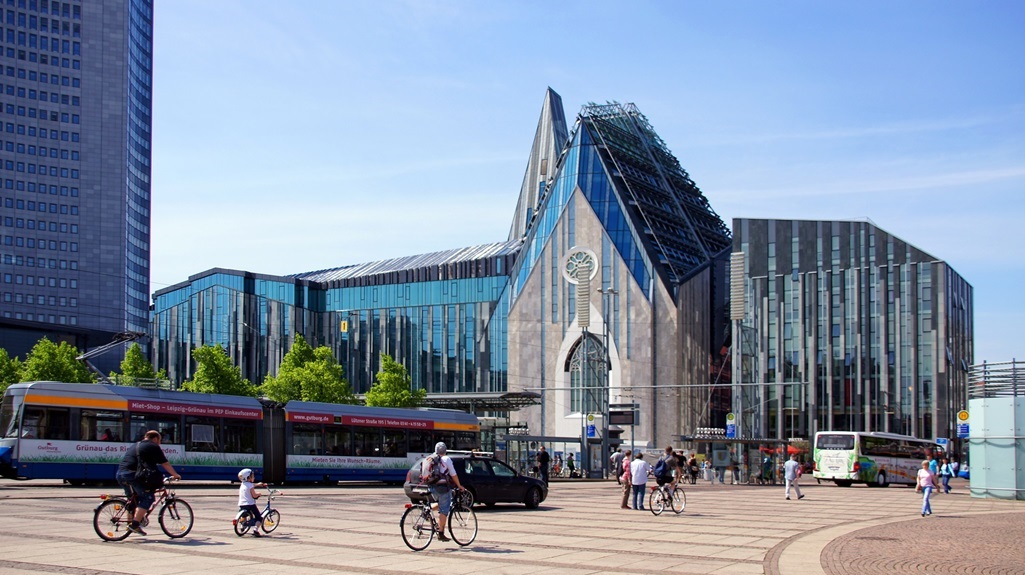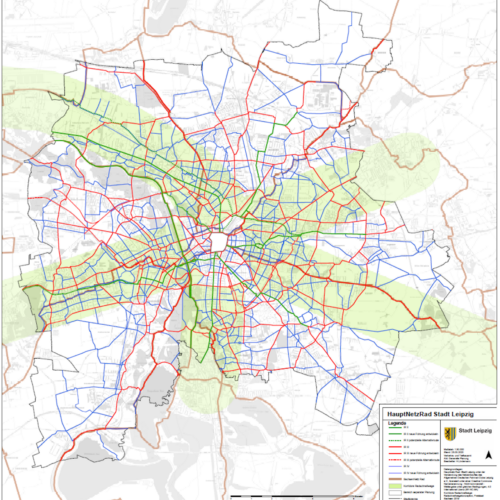With a population of over 600,000, Leipzig is a diverse and vibrant German city that has long been committed to promoting cycling. To encourage more people to use bicycles and travel safely, the City Council aims to expand and promote cycling more systematically. To facilitate thorough analysis and implementation, the city of Leipzig commissioned experts from PTV Transport Consult to develop the Cycling Development Plan 2030+, updating the existing plan from 2010-2020.
The importance of local mobility
The importance of local mobility has increased significantly in recent years. Leipzig already has a classified bicycle network. Since two thirds of the main road network still has no facilities for cyclists and needs to be gradually improved, it has to be reviewed and further developed. Thomas Dienberg, Mayor and Councillor for Urban Development and Construction, announced the promotion of cycling and walking as the most important “building block for significantly enhancing the quality of life in inner-city areas.” As part of the new Cycling Development Plan, Leipzig’s approach to enhancing its cycling network is grounded in comprehensive data analysis.
Cycling Development Plan for data analysis
In line with German guidelines for integrated network design, the cycling network in Leipzig is organized into three hierarchical levels: regional connections (“priority routes”), key urban connections (“main routes”), and local connections (“basic routes”). Before the project began, the city of Leipzig conducted a comprehensive survey of this network.
PTV Transport Consult experts carried out the survey and used the data to automatically check the suitability of the bicycle infrastructure. The cycling infrastructure was also evaluated according to German guidelines for standardized cycling infrastructure assessments, which provide a methodology for evaluating user-friendliness. These assessments covered the entire classified network, though there were data gaps in areas where the cycling network deviates from paved paths, such as through parks.
Where is the cycling infrastructure insufficient?
The data was used to conduct a comprehensive analysis of the current cycling infrastructure and to identify measures for the Cycling Plan to establish a continuous infrastructure throughout the classified network. Additional data from the city of Leipzig, such as speed limits and motor vehicle traffic volumes, was also integrated with the cycling infrastructure data to inform the analysis.
During implementation, the existing cycling facilities were compared with the infrastructure types recommended by German design guidelines for cycling. This comparison helped identify gaps in the network. The data reveals that cycling infrastructure is missing in key areas: 7% of the priority routes, 14% of the main routes, and 12% of the basic routes lack cycling facilities.
The analysis also showed that protective lanes (which can be shared with cars when necessary) cover a similar distance in the network as regular cycle lanes, especially along main routes. Additionally, the widths of cycling facilities were evaluated, and areas needing improvement were identified. All measures identified through this data-driven approach were then prioritized using standardized criteria.
Recommendations of the Cycling Development Plan
The vision for 2030+ is centered around the motto “Cycling Connects Leipzig.” This highlights the areas where cycling can have a particularly positive impact: promoting social equity and cohesion within the city’s population, providing mobility for all generations, improving connections between neighborhoods, supporting Leipzig’s economy, and advancing sustainability and climate protection goals.
The infrastructure section of the Cycling Development Plan includes many additional recommendations. For example, shared routes for cyclists and pedestrians were analyzed, and measures for separation were developed. Another key issue that emerged during the public participation process was the condition of junctions, which were identified as one of the main concerns with the current infrastructure. Traffic data alone did not provide sufficient information to determine solutions for junctions across the board. Therefore, measures for improving junctions were informed in part by feedback gathered through online and in-person public consultations. In addition to these infrastructure improvements, the plan includes various communication and organizational measures. It also outlines strategic goals, performance indicators, and a monitoring framework to complete the concept.
Final results of Leipzig’s Cycling Development Plan
The City of Leipzig now possesses a comprehensive database detailing the condition of its cycling network and the necessary infrastructure improvements. This data can be integrated into the city’s geoinformation systems. The potential measures identified from the data allow for a rough cost estimate of building the required infrastructure throughout Leipzig’s cycling network. This enables more efficient planning of the financial and staffing resources needed to implement the Cycling Development Plan.
The potential of a Cycling Development Plan
More and more cities are exploring new transportation concepts, with a particular focus on promoting sustainable modes of transport – whether it’s Paris or Minneapolis, which leads the rankings in the U.S.
The rise of electric bicycles has significantly expanded both the usability of bikes and the range of routes that can be covered. “Developing a comprehensive cycling route plan is complex, but the effort is absolutely worth it,” says project manager Birgit Uhlig, summarizing the project. “Every additional kilometer people cycle as a result is a win.”





